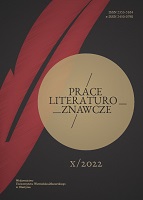The significance of symbolism and allegory in Cormac McCarthy’s The Road – a new era of post-apocalyptic fiction
The significance of symbolism and allegory in Cormac McCarthy’s The Road – a new era of post-apocalyptic fiction
Author(s): Dorota GładkowskaSubject(s): Studies of Literature, Theory of Literature, American Literature
Published by: Wydawnictwo Uniwersytetu Warmińsko-Mazurskiego w Olsztynie
Keywords: post-apocalyptic fiction; symbolism; allegory; iconicity in literature; evolution of the genre;
Summary/Abstract: McCarthy’s The Road is frequently described as a gloomy dystopia in which the redemption of humanity is impossible. This essay adopts a different perspective and focuses on the impact of the novel’s symbolism on the shifts in its overall message. The analysis leads to uncovering certain oppositions, apparent dichotomies and paradoxes incorporated in the novel’s recurring images and motifs, with particular emphasis on the motif of dream vision. McCarthy’s ascetic style is also considered in terms of its iconicity and functionality. In other words, this essay argues that the symbolically charged elements of The Road, due to their persistence in the text characterised by minimalism, form an intricate pattern which holds the novel’s allegorical message. The point advocated is that McCarthy’s literary symbolism leaves room for redemption in the world presented and signals the possibility of rebirth. It thus has the potential to gradually undermine and eventually subvert the initial perception of the novel as entirely pessimistic. All things considered, The Road is presented as a step forward in the evolution of post-apocalyptic fiction.
Journal: Prace Literaturoznawcze
- Issue Year: 2022
- Issue No: 10
- Page Range: 171-198
- Page Count: 28
- Language: English

